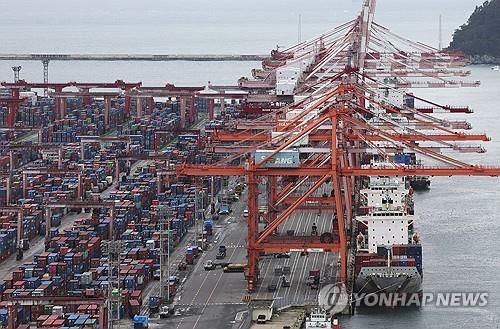- California Assembly OKs highest minimum wage in nation
- S. Korea unveils first graphic cigarette warnings
- US joins with South Korea, Japan in bid to deter North Korea
- LPGA golfer Chun In-gee finally back in action
- S. Korea won’t be top seed in final World Cup qualification round
- US men’s soccer misses 2nd straight Olympics
- US back on track in qualifying with 4-0 win over Guatemala
- High-intensity workout injuries spawn cottage industry
- CDC expands range of Zika mosquitoes into parts of Northeast
- Who knew? ‘The Walking Dead’ is helping families connect
S. Korea’s drop in exports eases in Sept. on chip sales recovery
South Korea’s exports fell for the 12th consecutive month in September but logged the smallest on-year decline so far this year, as global demand for semiconductors has been on the recovery track, the industry ministry said Sunday.
Outbound shipments fell 4.4 percent on-year to US$54.66 billion last month, according to the data compiled by the Ministry of Trade, Industry and Energy.
Exports have marked an on-year drop since October last year amid aggressive monetary tightening by the United States and other major economies to bring inflation under control and a global economic slowdown. It is the first time since 2020 that exports have declined for 12 months in a row.
But September saw the smallest on-year fall in exports so far this year, raising hopes for an upturn in the coming months.
The country’s outbound shipments skidded 8.3 percent in August following a 16.2 percent decline the previous month. In the first quarter, exports fell 12.7 percent on-year and the figure for the second quarter stood at 16.2 percent.

Despite the fall in exports, the country logged a trade surplus of $3.7 billion in September, the largest volume in two years and the fourth straight gain, as imports marked a sharper decline.
Imports fell 16.5 percent on-year to $50.96 billion last month, as energy imports retreated 36 percent on-year, the ministry said. South Korea depends on imports for most of its energy needs.
In June, the country reported a trade surplus for the first time in 16 months following the longest ever shortfall since 1997, which lasted from March 2022 through May 2023 as a result of high energy prices.
By sector, exports of semiconductors, the country’s key export item, fell for the 14th month in a row, dropping 13.6 percent on-year to $9.94 billion in September on falling demand and a drop in chip prices.
But global chip sales have shown signs of recovery in recent months, and September saw the highest monthly export value so far this year, according to the ministry.
Exports of petroleum products lost 6.8 percent to $4.9 billion and those of petrochemicals went down 6.1 percent to $3.82 billion on-year.
Car exports, however, jumped 9.5 percent on-year to $5.23 billion last month, and global sales of machinery climbed 9.8 percent to $4.39 billion.
Steel products enjoyed export growth of 6.9 percent to come to $2.87 billion, and sales of display items rose 4.2 percent to $1.81 billion.
Exports of auto parts, however, lost 3.5 percent to $1.94 billion, and those in the biohealth sector and sales of secondary batteries dwindled 15 percent and 16.3 percent, respectively.
By destination, shipments to China, the top trading partner, fell 17.6 percent on-year to $11 billion in September amid a slowdown in the Chinese economy, though the export value reached the largest amount this year.
Sales in the Association of Southeast Asian Nations (ASEAN) went down 8 percent on-year to $9.41 billion. ASEAN comprises Brunei, Cambodia, Indonesia, Laos, Malaysia, Myanmar, the Philippines, Thailand, Singapore and Vietnam.
In contrast, exports to the United States grew 8.5 percent to $10.04 billion, and shipments to the European Union rose 6.5 percent to $5.76 billion.
Exports to South American nations surged 18.2 percent to $2.4 billion, while those to the Middle East fell 2.2 percent to $1.38 billion.
“Exports have shown signs of improvement and could rebound, though we are facing unfavorable external conditions, such as high interest rates, an economic slowdown in China and supply chain issues,” Industry Minister Bang Moon-kyu said.
“The government will prioritize export growth and extend all available support,” he added.
South Korea releases its full monthly export data on the first day of every month.











